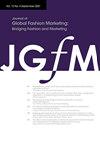Effects of consumer characteristics and product presentations on online apparel impulse buying
IF 5.5
Q2 BUSINESS
引用次数: 1
Abstract
ABSTRACT In the current study, we examined three consumer characteristics (i.e. perceived hedonic value of apparel, perceived symbolic value of apparel, and impulsive apparel shopping tendency) and ten online product presentation methods (i.e. organized product displays, attractive product displays, detailed product descriptions, large images, good quality pictures, products pictured from various angles, products pictured in all available colours, images that coordinate various items, helpful size charts, and a visual model) to understand the interactions between themselves and their relationships with online apparel impulse buying. The data were collected by an online survey that involved U.S. college students of ages 18 to 22 who had purchased apparel online within the past six months, and 262 useful responses were received. The results show that perceived hedonic value and symbolic value of apparel are antecedents of impulsive apparel shopping tendency. Impulsive tendency is a predictor of online apparel impulse buying. Three of the ten product presentation methods have both significant direct effects on online apparel impulse buying and moderating effects on the relationship between impulsive tendency and impulse buying. Four presentation methods do not have significant direct effects but have significant moderating effects, making the effect of impulsive tendency on impulse buying stronger.消费者特征和产品展示对在线服装冲动购买的影响
在本研究中,我们考察了三种消费者特征(即感知到的服装享乐价值、感知到的服装象征价值和冲动的服装购物倾向)和十种在线产品展示方法(即有组织的产品展示、有吸引力的产品展示、详细的产品描述、大图片、高质量的图片、从不同角度拍摄的产品、所有可用颜色的产品、协调各种商品的图片、有用的尺寸图表和视觉模型),以了解他们自己之间的互动以及他们与在线服装冲动购买的关系。这些数据是通过一项在线调查收集的,调查对象是在过去六个月内在网上购买过服装的18至22岁的美国大学生,共收到262份有用的回复。结果表明,服装的享乐价值和象征价值是服装冲动消费倾向的前因。冲动倾向是在线服装冲动购买的预测因子。10种产品展示方式中有3种对在线服装冲动购买具有显著的直接影响,同时对冲动倾向与冲动购买之间的关系具有显著的调节作用。四种呈现方式均不具有显著的直接效应,但具有显著的调节效应,使得冲动倾向对冲动购买的影响更强。
本文章由计算机程序翻译,如有差异,请以英文原文为准。
求助全文
约1分钟内获得全文
求助全文
来源期刊

Journal of Global Fashion Marketing
BUSINESS-
CiteScore
6.90
自引率
31.60%
发文量
34
期刊介绍:
The Journal of Global Fashion Marketing is a quarterly journal that publishes peer-reviewed conceptual and empirical papers and business cases of original works that significantly contribute to the overall advancement of marketing theory, research, and practice in fashion, design, and culture. JGFM endeavors to be a “global bridge” connecting marketing scholars and practitioners in fashion, design, and culture throughout the world. We publish high-quality scholarly articles on marketing written by contributors representing the leading academic authors. As we state on the cover of every issue, our positioning statement, our value added to the marketing scholar readership, is truly to “Bridge Fashion and Marketing” 1. Monitor and analyze global fashion marketing trends. 2. Generate and integrate new ideas and theories related to fashion, luxury, and culture marketing theory and practice. 3. Apply new research methods and techniques in fashion, luxury, and culture marketing. 4. Explore and disseminate cutting edge fashion marketing practices. JGFM welcomes manuscripts that provide fresh, innovative insight to any topic in the field of fashion, luxury, and culture marketing. Both conceptual and empirical works are valued, so long as the manuscript addresses substantive issues in marketing.
 求助内容:
求助内容: 应助结果提醒方式:
应助结果提醒方式:


